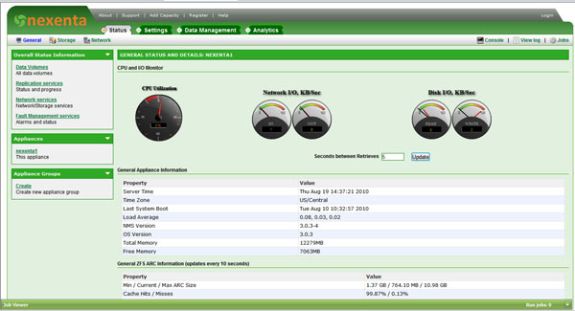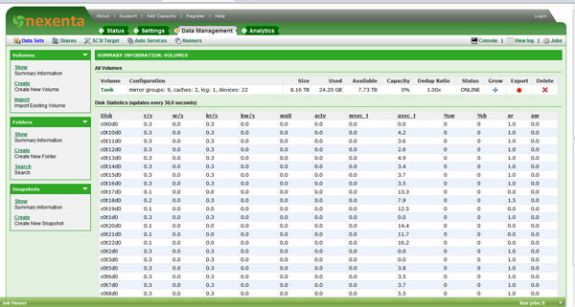ZFS - Building, Testing, and Benchmarking
by Matt Breitbach on October 5, 2010 4:33 PM EST- Posted in
- IT Computing
- Linux
- NAS
- Nexenta
- ZFS
Nexenta
Nexenta is to OpenSolaris what OpenFiler is to Linux or FreeNAS is to FreeBSD. It is a purpose built version of OpenSolaris designed primarily around storage networking including NFS, CIFS, and iSCSI/FC block based storage. Nexenta has taken a lot of time building a great front-end to manage ZFS enabled storage and integrate a plug-in manager that can extend the abilities of a standard x86 platform to rival the best
Nexenta comes in three flavors, Nexenta Core, Nexenta Community, and Nexenta Enterprise. The availability of these three versions allows you to select what kind of product you want, and what kind of expenditures that you will incur.
Nexenta Core is the most basic of the options, but it is also the most forgiving in terms of licensing. Nexenta Core is a command line interface platform only. It is based on an OpenSolaris kernel, and an Ubuntu Userland. There is no limit to the amount of storage that you can configure or use with Nexenta Core, and it is completely free. Nexenta Core can be found here.
Nexenta Community is the next step up. Nexenta Community is based on Nexenta Core, and includes a great GUI interface for managing all aspects of the storage platform. Nexenta Community is also free, but it is limited to 12TB of used storage. Nexenta Community Edition can be found here.
Nexenta Enterprise is the top-level offering. Nexenta Enterprise is a superset of Nexenta Community with many Enterprise level features, including support options. Nexenta Enterprise is licensed based on RAW storage capacity. You can find pricing information here.
Screenshots of web GUI
Nexenta has been very easy to use in our testing. After a few minutes of familiarization with the interface everything is pretty straight forward. You can go from a bare installation to something that has an array configured, an iSCSI target configured, and is ready to take data in a matter of 5-10 minutes. All of the features for sending out notifications and for lighting up indicator lights work as expected and are easy to configure. With just a few menu clicks you're ready to enter all of the information that the system needs to notify you about any problems that it encounters.
Some of the shortcomings that we saw in the Nexenta Enterprise offering were in the reporting and support areas of the product. We did not investigate the reporting problem in depth, as it was not pertinent to the performance data of the system. We would expect that with a little troubleshooting it would be something that would be easily resolved. Throughout the testing process though the daily reports stated that there was no network traffic being generated even though we were loading the interface quite heavily during testing.
This brings us to our next issue that we had with Nexenta, and that was the support channels. We would have gladly troubleshot the issues with reporting if we thought it was going to be done in a timely manner. Since we were using the Enterprise Trial license the support was lackluster at best. We were assured by sales representatives that paid-for support is much faster and much better than the "free trial" support. Free Trial support is treated as their lowest priority support queue. We were not impressed with this as we have always thought of a time-limited free trial period to be pre-sales. If you want to convert someone from a non-paying free trial to a paid product, show them how good the product and support is during that period.












102 Comments
View All Comments
vla - Tuesday, October 5, 2010 - link
Along the lines of the "Opensolaris is kind of dead" threads, I'd really like to see an article like this for BTRFS. It's about to become the standard filesystems for Fedora and Ubuntu in the near future, and I'd love to get some AnandTech depth articles about it.. what it can do, what it can't. How it compares to existing Linux filesystems, how it compares to ZFS, etc.andersenep - Tuesday, October 5, 2010 - link
When btrfs is ready for production use, let me know. From what I have seen it is still very much experimental. When it's as stable and proven as ZFS, I would love to give it a try. I have severe doubts that Oracle will continue to invest in its development now that it owns ZFS.Khyron320 - Wednesday, October 6, 2010 - link
I have never heard of any caching feature mentioned for BTRFS and it is not mentioned on the wiki anywhere. Is this a planned feature?http://en.wikipedia.org/wiki/Btrfs#Features
Sabbathian - Wednesday, October 6, 2010 - link
Only site where you can find articles like these.... thank you guys ... ;)lecaf - Wednesday, October 6, 2010 - link
Hiwhy not do some extra testing with Windows Storage Server R2 (just released a few days ago)
I'm sure it would lag behind but it could be interesting to see how much.
Mattbreitbach - Wednesday, October 6, 2010 - link
I do not believe that Windows Storage Server is an end-user product. I believe that it is only released to OEM's to ship on their systems. At this time we have no route to obtain Windows Storage Server.lecaf - Wednesday, October 6, 2010 - link
True its OEM only and not public but "evaluation" version is available with Technet and MSDNWithout a license key you can run it for 180 days (like all new MS OS BTW)
but you can also try this
http://www.microsoft.com/specializedservers/en/us/...
Just a registration and you get the software. (Read license because benchmarking is sometimes prohibited)
Sivar - Wednesday, October 6, 2010 - link
BSD supports ZFS as well, and it is far from dead.Of course, it's also far from popular.
Guspaz - Wednesday, October 6, 2010 - link
"We decided to spend some time really getting to know OpenSolaris and ZFS."OpenSolaris is a dead operating system, killed off by Oracle. Points for testing Nexenta, since they're the ones driving the fork that seems to be the successor to OpenSolaris, but basing your article around a dead-end OS isn't very helpful to your readers...
Mattbreitbach - Wednesday, October 6, 2010 - link
When this project was started, OpenSolaris was far from dead. We decided to keep using OpenSolaris to finish the article because a viable alternative wasn't available until three weeks ago. If we were to start this article today, it would be based on OpenIndiana. Some of our preliminary testing of OpenIndiana indicate that it performs even better than OpenSolaris in most tests.